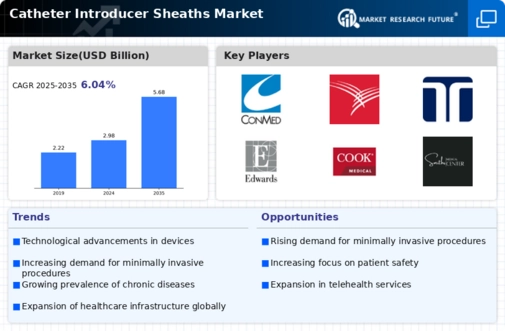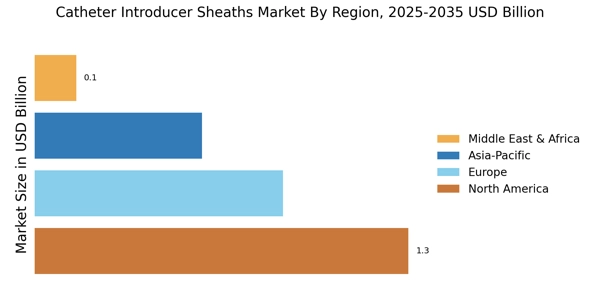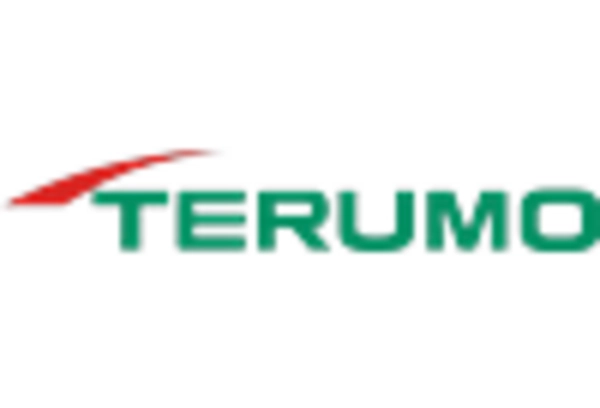Increasing Prevalence of Cardiovascular Diseases
The rising incidence of cardiovascular diseases is a critical driver for the Catheter Introducer Sheaths Market. As the global population ages, the prevalence of conditions such as coronary artery disease and heart failure is escalating. This trend necessitates the use of catheter-based interventions, which often require introducer sheaths for effective access to the vascular system. According to recent statistics, cardiovascular diseases account for a significant percentage of global mortality, prompting healthcare systems to invest in advanced medical devices. The demand for catheter introducer sheaths is expected to increase in tandem with the growing number of cardiovascular procedures, including angioplasty and stenting. Consequently, this driver is likely to play a pivotal role in shaping the future landscape of the catheter introducer sheaths market.
Growing Focus on Patient Safety and Quality of Care
The emphasis on patient safety and quality of care is becoming a paramount concern within the healthcare sector, directly impacting the Catheter Introducer Sheaths Market. Regulatory bodies and healthcare organizations are increasingly prioritizing the development and use of devices that minimize risks associated with procedures. This focus has led to the introduction of safety-engineered catheter introducer sheaths designed to reduce the likelihood of complications such as infections and vascular injuries. As hospitals and clinics strive to meet stringent safety standards, the demand for high-quality, reliable introducer sheaths is likely to increase. This trend not only enhances patient outcomes but also aligns with the broader goals of healthcare systems to improve overall care quality, thereby driving market growth.
Technological Innovations in Catheter Introducer Sheaths
The Catheter Introducer Sheaths Market is experiencing a surge in technological innovations that enhance the performance and safety of these devices. Recent advancements include the development of sheaths with integrated hemostatic valves, which minimize blood loss during procedures. Additionally, the introduction of materials that reduce friction and improve maneuverability is becoming increasingly prevalent. These innovations not only improve patient outcomes but also streamline surgical procedures, potentially reducing operation times. The market for catheter introducer sheaths is projected to grow at a compound annual growth rate of approximately 6% over the next few years, driven by these technological enhancements. As healthcare providers seek to adopt the latest technologies, the demand for advanced catheter introducer sheaths is likely to rise, further propelling the market forward.
Rising Adoption of Minimally Invasive Surgical Techniques
The shift towards minimally invasive surgical techniques is significantly influencing the Catheter Introducer Sheaths Market. These techniques offer numerous advantages, including reduced recovery times, lower risk of complications, and minimal scarring. As healthcare providers increasingly adopt these methods, the demand for catheter introducer sheaths, which facilitate access to the vascular system during such procedures, is expected to rise. Market analysis indicates that minimally invasive surgeries are projected to grow at a rate of 8% annually, further driving the need for specialized introducer sheaths. This trend reflects a broader movement within the medical community to enhance patient care through innovative surgical approaches, thereby positioning the catheter introducer sheaths market for sustained growth.
Expansion of Healthcare Infrastructure in Emerging Markets
The expansion of healthcare infrastructure in emerging markets is a significant driver for the Catheter Introducer Sheaths Market. As countries invest in modernizing their healthcare systems, the demand for advanced medical devices, including catheter introducer sheaths, is expected to rise. This growth is particularly evident in regions experiencing rapid urbanization and an increase in healthcare access. The establishment of new hospitals and surgical centers is likely to create a burgeoning market for catheter-based interventions, thereby increasing the need for introducer sheaths. Market forecasts suggest that emerging economies could witness a growth rate of 7% in the adoption of these devices, reflecting the potential for substantial market expansion in the coming years.


















Leave a Comment